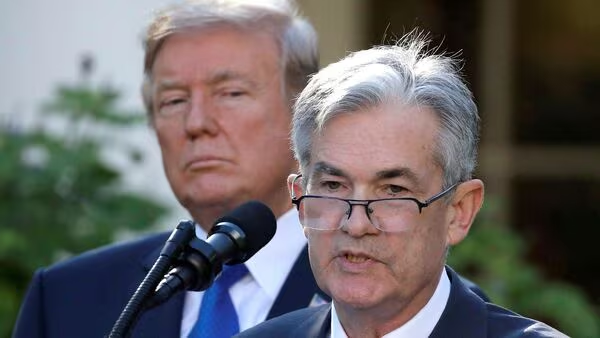In a political and economic move that has drawn national and international attention, President Donald Trump pushes Fed Chair to lower rates, again putting pressure on the Federal Reserve to take aggressive action to stimulate the U.S. economy. As the world continues to face economic uncertainties, Trump’s demand has reignited the debate over how independent the Federal Reserve should remain and whether lower interest rates are the right path forward.
In this article, we’ll break down why President Trump is pushing for rate cuts, how the Federal Reserve is responding, and what it means for the economy, investors, and the average American.
Why Trump Wants Lower Interest Rates
President Trump has consistently advocated for lower interest rates throughout his presidency. He believes that the U.S. economy could perform even better if borrowing costs were reduced. His reasoning includes:
- Stimulating Economic Growth: Lower rates typically encourage consumers and businesses to borrow and spend more, leading to increased economic activity.
- Boosting the Stock Market: Rate cuts often lead to stock market gains, which Trump frequently highlights as a barometer of his administration’s success.
- Countering Global Competition: Trump argues that other countries like China and the Eurozone have very low or even negative rates, giving them an unfair advantage.
Speaking at a press conference recently, Trump stated, “The Fed needs to step up and do what’s necessary. Other countries are playing the game, and we should not sit back and watch.”
How the Federal Reserve Operates
To understand the situation better, it’s important to know how the Federal Reserve works. The Fed is an independent central bank responsible for managing the nation’s monetary policy. It uses interest rates to control inflation, support employment, and stabilize the financial system.
The Fed’s independence means it operates without direct political influence, although it does take into account economic conditions and projections. Its key tool is the federal funds rate — the interest rate at which banks lend money to each other overnight.
When the Fed lowers rates, it makes borrowing cheaper. When it raises rates, borrowing becomes more expensive, usually to keep inflation in check.
The Fed Chair’s Response to Trump’s Pressure
Current Fed Chair Jerome Powell has largely stayed silent on the political noise, maintaining that the Federal Reserve is guided by data and long-term economic interests rather than short-term political pressure. He has said that the Fed is committed to its dual mandate: maximum employment and price stability.
However, Powell and his colleagues are aware of the growing calls for rate cuts — not just from the White House, but also from some market analysts who believe economic risks are rising due to:
- Global trade tensions
- Slowing manufacturing
- Uncertain job growth forecasts
- Weakening business investment
Despite this, Powell has not promised any sharp or sudden rate cuts. Instead, the Fed has taken a “wait-and-see” approach, evaluating economic indicators before making a move.
What Happens When Interest Rates Are Lowered?
The idea behind lower interest rates is simple: make money cheaper to borrow, and people will spend more. But the actual impact is broader:
Pros of Lower Interest Rates:
- Cheaper Loans: Lower mortgage, auto, and student loan rates.
- Stimulated Business Investment: Companies may borrow more to expand.
- Stock Market Boost: Lower rates often lift equity prices.
- Economic Growth: Consumer and business spending typically rise.
Cons of Lower Interest Rates:
- Lower Savings Returns: Savers earn less interest in their bank accounts.
- Inflation Risk: Cheap money can overheat the economy.
- Asset Bubbles: Real estate and stock prices may become overvalued.
- Limited Tools in a Crisis: If rates are already low, the Fed has fewer options during a recession.
So while Trump sees the short-term benefits, economists warn that aggressive rate cuts could pose longer-term risks.
Trump vs. the Fed: A Long-Running Tension
This is not the first time that Trump has publicly clashed with the Federal Reserve. Throughout his term, he criticized the Fed for not cutting rates faster or further. At one point, he even suggested firing Powell — though legal experts debate whether a President can actually remove a Fed Chair without cause.
The central concern among critics is that presidential pressure undermines the Fed’s credibility. If investors believe the Fed is acting politically, it may damage confidence in U.S. monetary policy — a vital pillar of the country’s financial system.
Still, Trump’s comments have often found support among investors and business groups who want to see a more aggressive Fed, especially during uncertain times.

What Economic Indicators Are Saying
To fairly assess whether rate cuts are justified, we need to look at the data:
- Unemployment: Still relatively low, though job growth has slowed.
- Inflation: Below the Fed’s 2% target — a signal that there’s room to lower rates without risk.
- GDP Growth: Slower than expected, but still positive.
- Consumer Confidence: Mixed, with some recent declines due to inflation and housing costs.
- Global Factors: Weakness in China and Europe, plus ongoing supply chain disruptions, are affecting U.S. exports.
In short, the data presents a mixed picture, which is why the Fed is treading carefully.
How the Markets React
Markets tend to react quickly to any signs that the Fed may change interest rates. When Trump pushes the Fed Chair to lower rates, Wall Street pays close attention.
Typically, the stock market rises on news or speculation of a potential rate cut. Bond yields fall, and the dollar may weaken as lower rates reduce the return on U.S. assets.
However, markets also want clarity. Constant public pressure from the President can cause uncertainty, leading to volatility in the short term.
Voices of Support and Criticism
Supporters of Trump’s Push:
- Real Estate Industry: Lower mortgage rates are good for homebuyers and builders.
- Stock Traders: Equity markets tend to rally after rate cuts.
- Retailers: Consumer spending usually improves when borrowing is cheaper.
Critics of Trump’s Push:
- Economists: Many warn of creating bubbles or long-term inflation.
- Former Fed Officials: Say political interference is a dangerous precedent.
- Savers: Americans relying on interest income from savings are affected.
One former Fed governor commented, “The Fed must remain above politics. The minute it bends to pressure, it loses its power to stabilize markets.”
What It Means for Everyday Americans
If the Fed decides to cut rates in the coming months, average Americans might notice:
- Lower interest on mortgages and car loans
- Higher home prices due to increased demand
- Possibly higher inflation for everyday items
- Lower returns on savings and retirement accounts
That’s why this debate isn’t just about economics or politics — it affects every household, borrower, and investor.
The Bigger Picture: U.S. Economy in Transition
As Trump pushes for lower rates, the U.S. economy finds itself at a crossroads. Inflation has moderated, but not disappeared. Growth continues, but at a slower pace. Uncertainty — from elections, wars, and climate events — clouds long-term forecasts.
In that context, Trump’s public campaign to lower rates is more than a financial tactic — it’s a political statement. He wants to be seen as pro-growth, pro-market, and pro-jobs heading into future elections.
But the final decision lies with the Federal Reserve. Its challenge is to weigh economic reality against political pressure, and act in the best long-term interests of the American people.
Conclusion
The debate over interest rates is far from over, and it’s one that will shape the future of the U.S. economy. As President Trump pushes Fed Chair to lower rates, the spotlight is now firmly on Jerome Powell and his colleagues. They must navigate not only economic indicators, but also the growing noise of political opinion.
Whether or not the Fed acts soon, this moment has underscored the fragile balance between economic policy and political influence a balance that will continue to be tested in the months ahead.
Read Next – Justice Department Sues Los Angeles Over Immigration Policies





